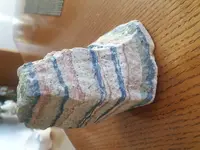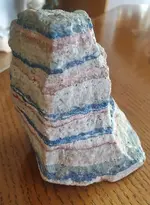You are using an out of date browser. It may not display this or other websites correctly.
You should upgrade or use an alternative browser.
You should upgrade or use an alternative browser.
RustyGold
Gold Member
- Joined
- Aug 16, 2013
- Messages
- 9,458
- Reaction score
- 11,155
- Golden Thread
- 0
- Location
- Southern California
- Detector(s) used
- XP Deus I & II
Xterra Elite Xterra Pro
- Primary Interest:
- Other
Welcome to TreasureNet. I wish I could help. There will be someone who can identify this stone. Good luck!
Upvote
0
RustyGold
Gold Member
- Joined
- Aug 16, 2013
- Messages
- 9,458
- Reaction score
- 11,155
- Golden Thread
- 0
- Location
- Southern California
- Detector(s) used
- XP Deus I & II
Xterra Elite Xterra Pro
- Primary Interest:
- Other
I’m probably wrong but possibly this.
Another accessory mineral, cordierite is found in high-magnesium, high-grade metamorphic rocks like hornfels and gneiss. Cordierite forms grains that display a shifting blue-to-gray color as you turn it. This unusual feature is called dichroism. If that isn't enough to identify it, cordierite is commonly associated with mica minerals or chlorite, its alteration products. Cordierite has few industrial uses.
Glassy luster; hardness of 7 to 7.5.
Dumortierite
This uncommon boron silicate occurs as fibrous masses in pegmatites, in gneisses and schists, and as needles embedded in knots of quartz in metamorphic rocks. Its color ranges from light blue to violet. Dumortierite is sometimes used in the production of high-quality porcelain.
Glassy to pearly luster; hardness of 7.
Glaucophane
Graeme Churchard/Flickr/CC BY 2.0
This amphibole mineral most often is what makes blueschists blue, although bluish lawsonite and kyanite may also occur with it. It is widespread in metamorphosed basalts, usually in felted masses of tiny needle-like crystals. Its color ranges from pale gray-blue to indigo.
Pearly to silky luster; hardness of 6 to 6.5.
Another accessory mineral, cordierite is found in high-magnesium, high-grade metamorphic rocks like hornfels and gneiss. Cordierite forms grains that display a shifting blue-to-gray color as you turn it. This unusual feature is called dichroism. If that isn't enough to identify it, cordierite is commonly associated with mica minerals or chlorite, its alteration products. Cordierite has few industrial uses.
Glassy luster; hardness of 7 to 7.5.
Dumortierite
This uncommon boron silicate occurs as fibrous masses in pegmatites, in gneisses and schists, and as needles embedded in knots of quartz in metamorphic rocks. Its color ranges from light blue to violet. Dumortierite is sometimes used in the production of high-quality porcelain.
Glassy to pearly luster; hardness of 7.
Glaucophane
Graeme Churchard/Flickr/CC BY 2.0
This amphibole mineral most often is what makes blueschists blue, although bluish lawsonite and kyanite may also occur with it. It is widespread in metamorphosed basalts, usually in felted masses of tiny needle-like crystals. Its color ranges from pale gray-blue to indigo.
Pearly to silky luster; hardness of 6 to 6.5.
Upvote
0
Back-of-the-boat
Gold Member
- Joined
- Apr 18, 2013
- Messages
- 7,019
- Reaction score
- 8,855
- Golden Thread
- 0
- Location
- California
- Detector(s) used
- AT GOLD/Garrett /C.Scope cs4PI/Garrett(carrot) pro pointer/ 5x8 double d coil and sniper coil/Lesche digger/Lesche "T" handle shovel.
- Primary Interest:
- All Treasure Hunting
Wrong type of stone what he has would be classified as sedimentary not metamorphic Sediment means the laying down of layers basically.
Upvote
0
DizzyDigger
Gold Member
- Joined
- Dec 9, 2012
- Messages
- 6,868
- Reaction score
- 14,754
- Golden Thread
- 0
- Location
- Concrete, WA
- Detector(s) used
- Nokta FoRs Gold, a Gold Cube, 2 Keene Sluices and Lord only knows how many pans....not to mention a load of other gear my wife still doesn't know about!
- Primary Interest:
- Prospecting
Upvote
0
Similar threads
- Replies
- 10
- Views
- 431
Users who are viewing this thread
Total: 1 (members: 0, guests: 1)





